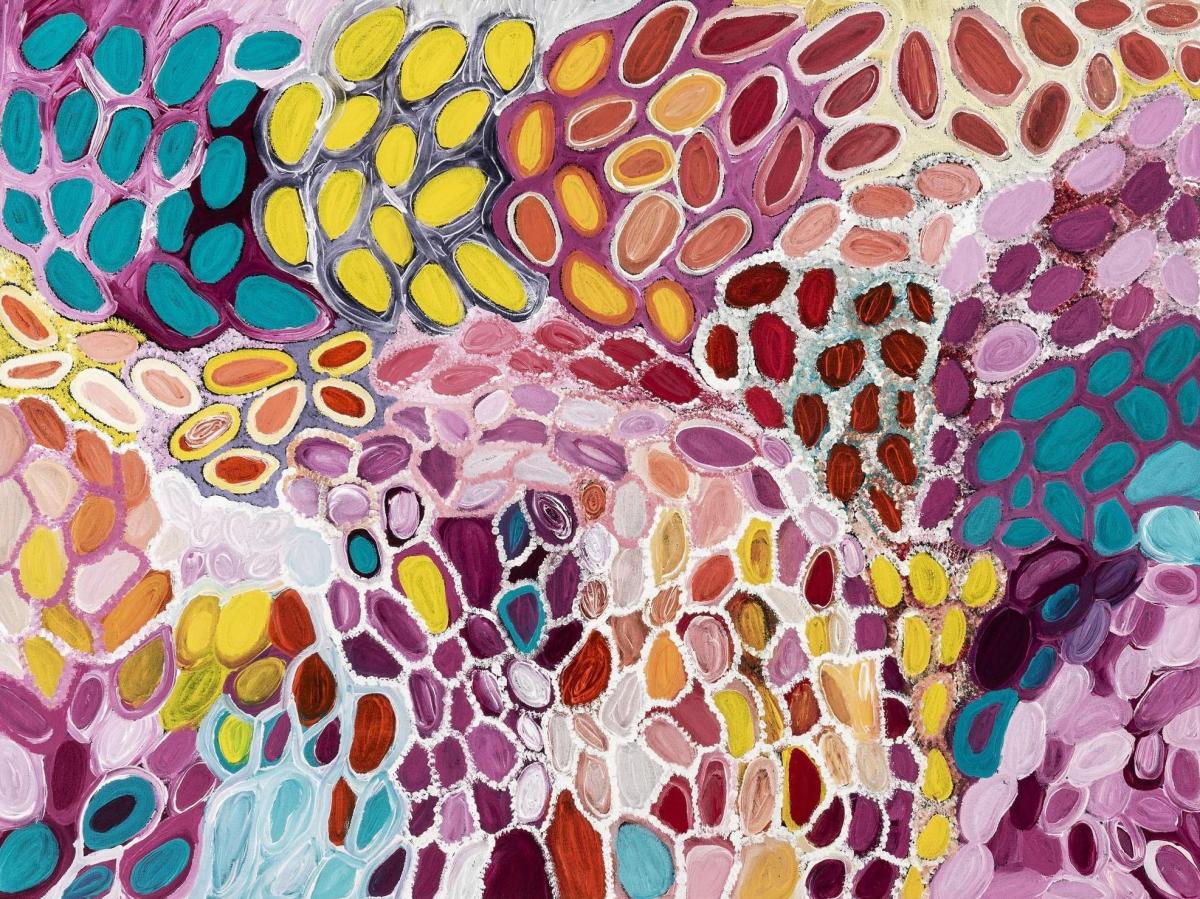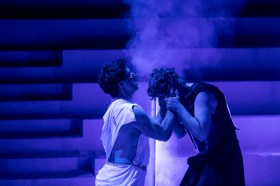Amanda Jane Gabori, My Country, Mornington Island Art. Image via Cairns Indigenous Art Fair.
Recent archaeological discoveries suggest that the history of Australia’s First Peoples started far earlier than previously documented.
Instead of the 65,000 years of continuous human occupation suggested by excavations at Madjedbebe (a rock shelter near Kakadu), the latest dates – based on research conducted at Moyjil (Point Ritchie) near Warrnambool, in south-east Victoria – suggest that Aboriginal Australians have occupied this land for twice as long as previously believed: up to 120,000 years.
While the science is still up for debate, one thing is certain: Australia is home to the world’s oldest continuous culture, and that culture’s contemporary expression is rich, vital and central to Australian identity today.
Here, we honour and celebrate that culture, and highlight the successes of contemporary Aboriginal and Torres Strait Islander art and activities across a range of organisations and artforms.
DIGITAL EXPRESSION PLAYS WITH CONTEMPORARY TENSIONS
The National Gallery of Australia (NGA) recently unveiled its first animated commission; an activation of the exterior façade of the gallery’s iconic brutalist architecture by contemporary Aboriginal artist Tony Albert. With the title I AM VISIBLE, the work begs all to bear witness to the realities of racial profiling and miscarriages of justice in contemporary Australian society.
Albert explained: ‘The visual elements of I AM VISIBLE are really representing the visibility, and in turn invisibility, of Aboriginal people, whether that be through the media, what we read, what we see. I play with the tensions.’
Read: Tony Albert shows black lives matter in first NGA façade commission
30 YEARS OF SIXTY FIVE THOUSAND
This year Bangarra turns 30. To commemorate this landmark anniversary the company is embarking on a national tour with a new production, Bangarra: 30 years of sixty five thousand. A three-part program, the production will feature Frances Rings’ Unaipon (from the 2004 production Clan), Czech choreographer Jiří Kylián’s Stamping Ground – marking the first time the company has presented a work by an international, non-Indigenous choreographer – and a yet-to-be announced selection of works from past Bangarra productions.
‘One thing that we love is telling stories, and the continuation of telling our stories. We’re the only major performing arts company that is Indigenous and we’re really aware of our responsibility as a carrier of stories, so for us to take this triple bill out to so many people is going to be really great,’ Stephen Page said.
Read: It’s Bangarra’s 30th anniversary and the whole country is invited
CREATING A NATIONAL INDIGENOUS ARTS AND CULTURAL AUTHORITY
For the last six months, consultations have been held across the country, with independent practitioners, cultural groups and representatives from cultural organisations contributing their views on how a National Indigenous Arts and Cultural Authority (NIACA) could best be established.
Participants have discussed issues including governance of such a peak body, how it would be structured, and the way it could best represent a national community with such diversity and complexity.
‘We find that people are really focused on elements of not just artistic practice and expression but also cultural practices, how people can be recognised for the connection of their culture to matters of heritage and country and the responsibilities that emerge from that,’ said Lydia Miller, Australia Council Executive Director, Aboriginal and Torres Strait Islander Arts.
Read: The necessity of community consultations in helping to form a NIACA
YARNING AT THE CAIRNS INDIGENOUS ART FAIR
When Janina Harding, the Artistic Director of Cairns Indigenous Art Fair was thinking of a theme for the Fair’s ten-year anniversary, it was important that the wording encouraged Indigenous artists to reflect on the rich cultural narratives embodied in their work.
‘The My Yarn Now theme not only encourages original languages to be honoured and expressed, but also deliberates 60,000 plus years of storytelling (and still not short of a yarn),’ Harding said.
Read: The rich storytelling culture that underpins Cairns’ Indigenous Art Fair
SHINING LIGHT ON COUNTRY
The latest edition of Parrtjima – A Festival in Light takes its cue from the United Nations Year of Indigenous Languages by adopting the theme, Language Expressions.
Creative director Rhoda Roberts AO told ArtsHub that among the new installations this year was an impressive illuminated tunnel, Angkentye Anpernirrentye-kerte – The Language of Kin, which will welcome guests to the festival space. The installation explores complex systems of kinship and features an accompanying audio soundscapes for a surreal experience.
In addition to dramatic light shows, the festival also features a range of workshops and live performances, including award-winning hip hop artist Baker Boy. ‘It is exciting that there is this voice of young people, and while they are using multi-media and Western instruments they are using language and continuing with the stories,’ Roberts said.
Read: Parrtjima is more than a light festival; it’s a celebration of Country
NEW ART FROM OLD STORIES
Established in 2005, Mornington Island Art Centre (MIArt or Mirndiyan Gununa) is an Aboriginal art centre that has recently enjoyed an exciting period of regeneration and rejuvenation. Located in Queensland’s remote Gulf of Carpentaria, the art centre is fully owned and controlled by an Indigenous Board and most of the staff are Indigenous. MIArt is dedicated to delivering locally relevant programs that ultimately produce internationally significant artworks by Indigenous artists.
‘These artists confidently tell their stories about their families and their deep-rooted connections to the Old People. This creates works of outstanding beauty and clarity because the culture is strong and central to everything,’ said manager John Armstrong.
Read: At MIArt, artists are preserving memories through strong contemporary artworks
THE TERRITORY ART TRAIL
The world’s largest art gallery isn’t in Paris, St. Petersburg or New York City. It’s the Northern Territory. From remote Aboriginal arts centres where practitioners explore ancient traditions with contemporary flair, to the electrifying performances of Yolngu hip-hop artist Baker Boy (2019’s Young Australian of the Year) the Territory’s 1.3 million square kilometres are packed with authentic and enriching experiences for the culture-hungry traveller.
Jo Nixon, Executive Officer of Alice Springs Beanie Festival, praised the vibrancy and diversity of the Territory’s arts sector: ‘The Territory abounds with unique and incredible arts – paintings, baskets, fabrics, dancing, and music. It’s also home to utterly unique headwear: the beanie. We are full of amazing festivals, exhibitions and performances seen nowhere else in the world and the Beanie Festival highlights the amazing, vibrant culture that we love,’ Nixon told ArtsHub.
Read: Discover Art Territory
ART TEACHING CULTURAL UNDERSTANDING
Aboriginal artists and curators at the Art Gallery of South Australia (AGSA) have worked with educators to embrace new ways of teaching Aboriginal and Torres Strait Islander art in a culturally sensitive and respectful way.
‘We had presented an earlier session with the general public, “Who’s afraid of Aboriginal art?”, and given the large numbers that attended, we stood back and thought this is something that educators would be super interested in, our approach to demystifying and debunking how you approach this material,’ said Assistant Director AGSA, Lisa Slade.
Read: Who’s afraid of Aboriginal art? Not the Art Gallery of SA
FROM THE NT TO THE WORLD
Sharing Territory stories beyond local parameters, Artback NT collaborates with Northern Territory artists to develop and tour unique works, propelling them into the national and international spotlight.
‘We take the work beyond initial ideas, beyond first presentations and tour it locally, regionally, nationally or internationally,’ Louise Partos, Executive Officer, Artback NT, told ArtsHub.
The organisation also brings unique cultural experiences to remote communities. ‘‘We specifically respond to gaps within the sector,’ Partos said. ‘Our Artists on Tour programs is about utilising Territory artists to deliver a whole range of workshops to schools, after school care, aged care facilities, and community centres,’ Partos said.
Read: Artback NT: Showcasing Northern Territory artists to global audiences
HOW LANGUAGE CAN CLOSE THE GAP
Of the 120 Indigenous languages surviving today, nine in every ten is endangered. Fortunately this year provides a great opportunity to raise awareness, take actions to preserve and to celebrate our original languages with the UN Nations General Assembly naming 2019 the International Year of Indigenous Languages (IY2019). And it’s not just about words.
The co-chair of the Steering Committee for IY2019, Craig Ritchie, sees the year as a step towards closing the gap. ‘We know in Australia that connecting with traditional languages has a positive impact on the health and wellbeing of Aboriginal and Torres Strait Islander people. So strengthening Indigenous languages will support happier and healthier communities,’ said Ritchie.
Read: Time to revitalise Australia’s Indigenous languages
INTERROGATING COLONIAL STEREOTYPES
From the first portraits of Aboriginal people in Queensland, to recent works by contemporary artists, Queen’s Land: Blak Portraiture explores and interrogates the dominant colonial stereotypes that have dictated the representation of Aboriginal people in the past.
The exhibition seeks to form new narratives around perception and presentation of black identity not only in Queensland but across Australia. The exhibition includes portraits by leading Indigenous and non-Indigenous artists to present new discourses around race and identity.
‘Works in the exhibition depict the first meetings and cursory observations of white and black people in Queensland, through to images by the descendants of those people, reflecting on or using early imagery, or recasting that imagery and reinventing it or reinterpreting it,’ said consultant curator Djon Mundine AO.
Read: Blak Portraiture reframes identity in Cairns
ART AS SELF-DETERMINATION
Adopting a new and experimental curatorial framework, Desert River Sea: Portraits of the Kimberley at the Art Gallery Western Australia (AGWA) is an ambitious survey exhibition of contemporary Aboriginal art from the Kimberley – a region covering hundreds of thousands of square kilometres in northern WA and encompassing some 200 Aboriginal communities and 30 language groups.
According to Carly Lane, a Murri woman from Queensland and Curator of Indigenous Australian and First Nations Arts at AGWA, Desert River Sea is far more than an exhibition.
‘It’s more than art – it’s about our lives as Aboriginal people including our place in Australian society. It’s also about celebrating who we are now and trying to build wider understanding of Aboriginal people and culture through art,’ she told ArtsHub.






